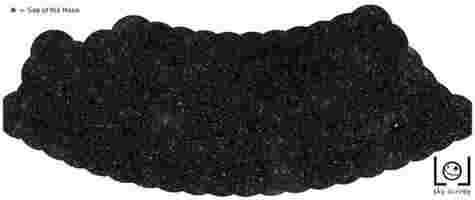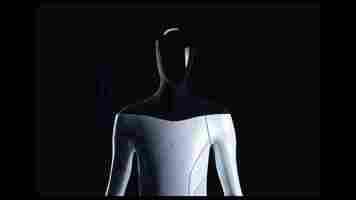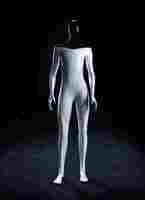This AI tool generates your creepy lookalikes to trick facial recognition
If you’re worried about facial recognition firms or stalkers mining your online photos, a new tool called Anonymizer could help you escape their clutches.

The app was created by Generated Media, a startup that provides AI-generated pictures to customers ranging from video game developers creating new characters to journalists protecting the identities of sources. The company says it built Anonymizer as “a useful way to showcase the utility of synthetic media.”
The system was trained on tens of thousands of photos taken in the Generated Media studio. The pictures are fed to generative adversarial networks (GANs), which create new images by pitting two neural networks against each other: a generator that creates new samples and a discriminator that examines whether they look real.
The process creates a feedback loop that eventually produces lifelike profile photos.
You have to buy a license to use Anonymizer for commercial purposes, but the tool is free for personal usage — as long as you don’t violate the terms and conditions .
Just upload a clear photo of your face looking straight ahead, and the system will spit out a grid of 20 doppelgängers. You could then pick one that resembles you and use it in place of the social media profiles scanned by the likes of Clearview AI .
Unlike many of the facial recognition systems it could trick, Anonymizer seemed to work fairly well on a diverse range of faces during our brief testing. But Generated Media admits it needs to do better:
However, many of the clones bear little resemblance to the face they replace. In some cases (including mine) it seems to suspect that the uploader is a child. I’m gonna take it as a compliment.
Nonetheless, Anonymizer could be a useful way of avoiding facial recognition systems. Still, there are risks of it being deployed for nefarious purposes, despite Generated Media prohibiting its use for any illegal activity, such as defamation, impersonation, or fraud.
The tool could also ascent our descent into a counterfeit world. But if you can’t beat ’em, I guess you might as well join ’em in the simulated reality.
HT – Thomas Smith
Supercomputers (and a few humans) create stunning sky map of 25,000 supermassive black holes
Astronomers have used a combination of low-frequency telescopes, supercomputers, and algorithms to create a vast sky map of 25,000 supermassive black holes.

The map shows thousands of twinkling dots that look like stars, but are actually enormous black holes, each of which is located in a different, distant galaxy.
The researchers pinpointed the celestial objects by analyzing radio emissions emitted by matter that was ejected when it got close to the black holes.


These emissions were detected by LOFAR (Low Frequency Array), an enormous radio telescope network spread across 52 stations in nine European countries.
LOFAR operates at the lowest frequencies that can be observed from Earth. However, its location produced a major problem for the study.
LOFAR’s observations are distorted by the ionosphere, a shell of free electrons that surrounds the Earth and acted like a cloudy lens over the telescope.
“It’s similar to when you try to see the world while immersed in a swimming pool,” explained study co-author Reinout van Weeren of the Leiden Observatory. “When you look up, the waves on the water of the pool deflect the light rays and distort the view.”
The researchers overcame this challenge by using supercomputers and new algorithms to correct the effect of the ionosphere every four seconds.
This allowed them to convert the radio signals into images of black holes.
The new map currently covers 4% of the Northern sky, but the astronomers plan to continue their work until they’ve charted the entire area.
Ultimately, they hope to uncover new insights into the structure of the universe.
Elon Musk’s Tesla Bot won’t make your sci-fi nightmares come true but is still a cause for concern
Elon Musk announced a humanoid robot designed to help with those repetitive, boring tasks people hate doing. Musk suggested it could run to the grocery store for you, but presumably it would handle any number of tasks involving manual labor.

Predictably, social media filled with references to a string of dystopian sci-fi movies about robots where everything goes horribly wrong.
As troubling as the robot futures in movies like I, Robot , The Terminator and others are, it’s the underlying technologies of real humanoid robots – and the intent behind them – that should be cause for concern.
Musk’s robot is being developed by Tesla. It’s a seeming departure from the company’s car-making business, until you consider that Tesla isn’t a typical automotive manufacturer. The so-called “ Tesla Bot ” is a concept for a sleek, 125-pound human-like robot that will incorporate Tesla’s automotive artificial intelligence and autopilot technologies to plan and follow routes, navigate traffic – in this case, pedestrians – and avoid obstacles.


Dystopian sci-fi overtones aside, the plan makes sense, albeit within Musk’s business strategy. The built environment is made by humans, for humans. And as Musk argued at the Tesla Bot’s announcement, successful advanced technologies are going to have to learn to navigate it in the same ways people do.
Yet Tesla’s cars and robots are merely the visible products of a much broader plan aimed at creating a future where advanced technologies liberate humans from our biological roots by blending biology and technology . As a researcher who studies the ethical and socially responsible development and use of emerging technologies , I find that this plan raises concerns that transcend speculative sci-fi fears of super-smart robots.
A man with big plans
Self-driving cars , interplanetary rockets and brain-machine interfaces are steps toward the future Musk envisions where technology is humanity’s savior. In this future, energy will be cheap, abundant and sustainable ; people will work in harmony with intelligent machines and even merge with them ; and humans will become an interplanetary species .
It’s a future that, judging by Musk’s various endeavors, will be built on a set of underlying interconnected technologies that include sensors, actuators , energy and data infrastructures, systems integration and substantial advances in computer power. Together, these make a formidable toolbox for creating transformative technologies.
Musk imagines humans ultimately transcending our evolutionary heritage through technologies that are beyond-human, or “super” human. But before technology can become superhuman, it first needs to be human – or at least be designed to thrive in a human-designed world.
This make-tech-more-human approach to innovation is what’s underpinning the technologies in Tesla’s cars, including the extensive use of optical cameras. These, when connected to an AI “brain,” are intended to help the vehicles autonomously navigate road systems that are, in Musk’s words, “ designed for biological neural nets with optical imagers ” – in other words, people. In Musk’s telling, it’s a small step from human-inspired “robots on wheels” to humanlike robots on legs.
Easier said than done
Tesla’s “full self-driving” technology, which includes the dubiously named Autopilot , is a starting point for the developers of the Tesla Bot. Impressive as this technology is, it’s proving to be less than fully reliable. Crashes and fatalities associated with Tesla’s Autopilot mode – the latest having to do with the algorithms struggling to recognize parked emergency vehicles — are calling into question the wisdom of releasing the tech into the wild so soon.
This track record doesn’t bode well for humanlike robots that rely on the same technology. Yet this isn’t just a case of getting the technology right. Tesla’s Autopilot glitches are exacerbated by human behavior . For example, some Tesla drivers have treated their tech-enhanced cars as though they are fully autonomous vehicles and failed to pay sufficient attention to driving. Could something similar happen with the Tesla Bot?
Tesla Bot’s ‘orphan risks’
In my work on socially beneficial technology innovation, I’m especially interested in orphan risks – risks that are hard to quantify and easy to overlook and yet inevitably end up tripping up innovators. My colleagues and I work with entrepreneurs and others on navigating these types of challenges through the Risk Innovation Nexus , an initiative of the Arizona State University Orin Edson Entrepreneurship + Innovation Institute and Global Futures Laboratory .
The Tesla Bot comes with a whole portfolio of orphan risks. These include possible threats to privacy and autonomy as the bot collects, shares and acts on potentially sensitive information; challenges associated with how people are likely to think about and respond to humanoid robots; potential misalignments between ethical or ideological perspectives – for example, in crime control or policing civil protests; and more. These are challenges that are rarely covered in the training that engineers receive, and yet overlooking them can spell disaster .
While the Tesla Bot may seem benign – or even a bit of a joke – if it’s to be beneficial as well as commercially successful, its developers, investors, future consumers and others need to be asking tough questions about how it might threaten what’s important to them and how to navigate these threats.
These threats may be as specific as people making unauthorized modifications that increase the robot’s performance – making it move faster than its designers intended, for example – without thinking about the risks, or as general as the technology being weaponized in novel ways. They are also as subtle as how a humanoid robot could threaten job security, or how a robot that includes advanced surveillance systems could undermine privacy.
Then there are the challenges of technological bias that have been plaguing AI for some time , especially where it leads to learned behavior that turn out to be highly discriminatory. For example, AI algorithms have produced sexist and racist results.
Just because we can, should we?
The Tesla Bot may seem like a small step toward Musk’s vision of superhuman technologies, and one that’s easy to write off as little more than hubristic showmanship . But the audacious plans underpinning it are serious — and they raise equally serious questions.
For instance, how responsible is Musk’s vision? Just because he can work toward creating the future of his dreams, who’s to say that he should? Is the future that Musk is striving to bring about the best one for humankind, or even a good one? And who will suffer the consequences if things go wrong?
These are the deeper concerns that the Tesla Bot raises for me as someone who studies and writes about the future and how our actions impact it . This is not to say that Tesla Bot isn’t a good idea, or that Elon Musk shouldn’t be able to flex his future-building muscles. Used in the right way, these are transformative ideas and technologies that could open up a future full of promise for billions of people.
But if consumers, investors and others are bedazzled by the glitz of new tech or dismissive of the hype and fail to see the bigger picture, society risks handing the future to wealthy innovators whose vision exceeds their understanding. If their visions of the future don’t align with what most people aspire to, or are catastrophically flawed, they are in danger of standing in the way of building a just and equitable future.
Maybe this is the abiding lesson from dystopian robot-future sci-fi movies that people should be taking away as the Tesla Bot moves from idea to reality — not the more obvious concerns of creating humanoid robots that run amok, but the far larger challenge of deciding who gets to imagine the future and be a part of building it.
Article by Andrew Maynard , Associate Dean, College of Global Futures, Arizona State University
This article is republished from The Conversation under a Creative Commons license. Read the original article .